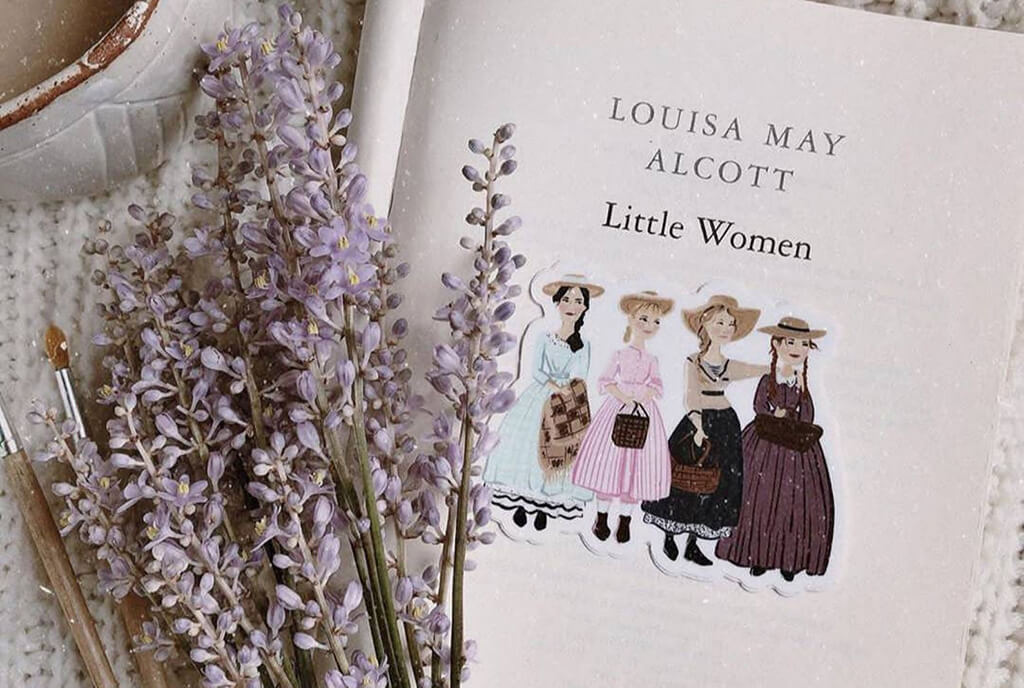“The garden had to be put in order, and each sister had a quarter of the little plot to do what she liked with,” Little Women, Louisa May Alcott
In the garden of life, each sister plays her respective role- whether it’s fighting our battles or cooking Maggi for us at 2 a.m. or poking us for fun. No matter which part they play, we turn to our sisters when the times are too dark or when the sun shines the brightest. And what better piece of literature to look up to, when celebrating sisterly love, than Louisa May Alcott’s Little Women.

“Sisters have the most intimate relationships compared to brother-sister or brother-brother pairs,” says Sarah Killoren, Ph.D., Associate Professor of Human Development and Family Science at the University of Missouri. “Sisters are friends, caregivers, sources of support and advice, but there can also be conflict and jealousy in their relationships. Little Women shows all of these different aspects of sisters’ relationships,” Killoren says.
It wasn’t the setting or the time period of Little Women that charmed me, but how realistically the author navigates the complexities of this relationship. The reader can’t help but laugh, cry, sing, dance and most importantly, relate with the sisters; and one constantly feels as if it is the manifestation of the bond they share with their sister.
Little Women underlines that in sisterly bonds conflicts may arise from the lack of understanding of one’s reasons behind making a certain decision, but at the end of the day, acceptance is the key. In Jo’s defense, who can blame her? Who doesn’t fear losing their sister to marriage and having to accept the fact that she would have new people she is going to prioritise over you, often failing to be at your disposal. Personally to me, Jo’s idea of running away from it all and building a new life was a brilliant one
Even though the characters Meg, Jo, Beth and Amy often act as one unit, the writer does not portray sisters to be idealistically affectionate with each other, nor are they portrayed as enemies. In fact, Little Women explores the complex aspects of sisterly bonds. The sisters may beat each other to death, but they are also united against any outsider who raises a finger on the other. The feelings of jealousy have also been shared differently in the text as it eventually transforms to happiness and pride, unlike many other popular narratives that pit women against each other.
Essentially, Alcott has focused on how in her socio-cultural milieu, women were expected to live up to certain expectations and standards. What stands out in the narrative is how incredible and different each of the sister’s personalities are. While Jo is a rebel, Beth finds happiness in the homely setting, Meg aspires to have a family of her own and Amy is stubborn and focused.

Being the eldest of the lot, Meg and Jo in Little Women share experiences that aren’t accessible to the younger ones, like going to the ball or theatre, and so they share an empathetic connection. Furthermore, the additional responsibility of being the second mother to Beth and Amy also makes them really compassionate towards each other. Being a hater of any kind of change, Jo pleads Meg not to get married for she fails to see the point but she just responds by saying, “Just because my dreams are different than yours, doesn’t mean they’re unimportant.”
Initially, Jo is extremely skeptical of Mr. Brooke and it reminded me how most lovers need to go through a sister’s scrutiny until she’s assured that the person is worthy of her sister’s time and affection. And this is no easy feat as almost every candidate fails to live up to the extremely high standards.
Also read: HBO’s Big Little Lies Review: The Little Big Truths About Women’s Lives
Little Women underlines that in sisterly bonds conflicts may arise from the lack of understanding of one’s reasons behind making a certain decision, but at the end of the day, acceptance is the key. In Jo’s defense, who can blame her? Who doesn’t fear losing their sister to marriage and having to accept the fact that she would have new people she is going to prioritise over you, often failing to be at your disposal. Personally to me, Jo’s idea of running away from it all and building a new life was a brilliant one.
The elder siblings are famously called the ‘third parent’ as they spend their lives filling the gaps and playing the roles that parents fail to. They start wearing different hats- the stylist, the disciplinarian, the roommate and the bodyguard among many others. Being the eldest two, Meg and Jo take under their wings the younger ones, Amy and Beth respectively, and it is heart warming to follow their arcs.
When Beth is sick, Jo plays the role of the caregiver and takes care of her day and night, never leaving her side for even a second. They truly shared an unconditional bond which makes their relationship nurturing as they become each other’s support systems in their lowest of times. Had it not been for Beth’s encouragement, Jo wouldn’t have picked her pen again. Little Women showcases how sisters push you off the cliff when you need it the most and when they have utmost faith that you would fly, and you do emerge as the best bird out there.
An all female space not only allows you to be yourself without having the fear of being judged but also empowers you to take on the challenges and pursue the ambitions you’re too afraid to.
The world would have you believe that women are enemies and all they do is fight over clothes, makeup and boys. Yes, we do all of that. But what society fails to tell you is that we all believe that our clothes suit the sister better, that she uses makeup in a much more artistic way and we may hold back compliments at times but she’s the prettiest girl to us. And boys? They really need to be scared of the sisters- one wrong move and they would be shown the door
Unmarred by any conflict, Jo and Beth emerge as soulmates, often understanding what the other leaves unsaid. From the beginning of the story, there is a certain kind of uneasiness and animosity between Jo and Amy in Little Women. Interestingly, the two of them are passionate but have completely opposite sets of values and here lies the point of contention. The writer sells her hair to support her family, while the artist takes pride in her vanity.
“Siblings typically fight about two things; whether things are fair in terms of them having the same opportunities and when siblings try to take something that is theirs. Both of these apply when you are talking about Jo and Amy,” says Killoren. When being denied the permission to go to the theatre with Jo and Meg, Amy sets Jo’s manuscript on fire as revenge. Being heartbroken by it, not only does Jo box Amy’s ears (and rightfully so), but also ceases all communication with her.
But when the younger one is about to drown when coming after Jo to apologise, it is this elder one who stays by her side, haunted by her guilt and fear that she could have lost her sister because of her anger. In addition, when Amy finds her husband in Jo’s best friend, Laurie, the latter forgives her almost instantly saying, “Life’s too short to be mad at one’s sister.”

As is often seen in a patriarchal setting, the elder sister needs to fight all the battles against misogyny to carve a path of her own. Consequently, the younger ones also benefit from it which seldom leads to the elder one feeling jealous that the other had it easy. But at the same time, forgiveness comes easily to her because she understands how difficult it is to survive in this world as a woman.
The world would have you believe that women are enemies and all they do is fight over clothes, makeup and boys. Yes, we do all of that. But what society fails to tell you is that we all believe that our clothes suit the sister better, that she uses makeup in a much more artistic way and we may hold back compliments at times but she’s the prettiest girl to us. And boys? They really need to be scared of the sisters- one wrong move and they would be shown the door.
Also read: How Social Media Has Become A Site For Sisterhood In the COVID-19 Pandemic
No matter how successful you get, it’s the sister who would always keep you grounded, who would always be the home that reminds you where you belong and even if the mother is gone (or is as good as gone), a sister’s love would supersede everything else. Personally for me, this relationship is exceptional and can’t be replicated in any other.
You may be mad at your sister for days or be engaged in your respective life, yet you always have faith that the day you reach out, she will hold your hand. If she is older than you, a little scolding is guaranteed, but the guardian angel would soon be at duty again.
Jo March says in Little Women, “I could never love anyone as I love my sisters.” Neither can I, Jo.
Featured Image Source: Bona Fide Bookworm
About the author(s)
Taanya is currently pursuing her Master’s degree in English Literature from Jamia Millia Islamia, New Delhi. Feminist Studies and Postcolonial Studies pique her interest. She reads all genres but has a special liking for LGBTQ literature and women’s writings. Her other obsessions include street food and strong coffee




